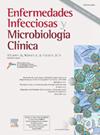抗寄生虫治疗对慢性蛛网膜下腔神经囊虫病有益吗?比较案例系列
IF 2.5
4区 医学
Q3 INFECTIOUS DISEASES
Enfermedades infecciosas y microbiologia clinica
Pub Date : 2025-10-01
DOI:10.1016/j.eimc.2025.01.007
引用次数: 0
摘要
背景:神经囊虫病在影响蛛网膜下腔时尤为严重。虽然抗寄生虫治疗有效地控制了感染,但它可能导致严重的并发症,特别是在蛛网膜下腔神经囊虫病(SUBNCC)中。本研究旨在描述一组SUBNCC患者的特征,重点关注他们的临床过程取决于治疗干预措施。方法:我们对1985年11月至2022年7月在某三级医院诊断为SUBNCC的患者进行了一项观察性回顾性研究。主要终点是描述该队列的临床进展和人口统计学特征。次要目的是比较接受抗寄生虫治疗和未接受治疗的患者的复发率。结果纳入15例患者,中位年龄31岁(24-54岁),女性占53%。最常见的原籍国是玻利维亚和厄瓜多尔,移民的中位数持续时间为8.1年(范围3-16年)。大约46.7%的患者至少经历过一次复发,其中最初接受抗寄生虫药物治疗的患者复发率为46%,单独接受类固醇治疗的患者复发率为50%。两组的并发症发生率相似。抗寄生虫药物治疗与单独使用糖皮质激素治疗的复发时间比较无统计学差异(共27次,17次使用抗寄生虫药物治疗,10次使用糖皮质激素治疗,p = 0.376)。结论:在SUBNCC患者中,单独使用皮质类固醇治疗的临床复发在并发症和复发率方面并不比使用抗寄生虫药物治疗的结果更差。本文章由计算机程序翻译,如有差异,请以英文原文为准。
Is antiparasitic treatment beneficial in chronic subarachnoid neurocysticercosis? A comparative case series
Background
Neurocysticercosis is particularly severe when affecting the subarachnoid space. While antiparasitic therapy effectively controls the infection, it can lead to significant complications, especially in subarachnoid neurocysticercosis (SUBNCC). This study aims to characterize a cohort of patients with SUBNCC, with a focus on their clinical course depending on therapeutic interventions.
Methods
We conducted an observational, retrospective study involving patients diagnosed with SUBNCC at a tertiary hospital between November 1985 and July 2022. The primary endpoint was to delineate the clinical progression and demographic features of the cohort. A secondary objective was to compare relapse rates between patients receiving antiparasitic treatment and those who did not.
Results
Fifteen patients were included, with a median age of 31 years (range 24–54), and 53% were female. The most common countries of origin were Bolivia and Ecuador, with a median duration from immigration of 8.1 years (range 3–16). Approximately 46.7% of patients experienced at least one relapse, with rates of 46% in patients initially treated with antiparasitic medication and 50% in those treated with steroids alone. Complication rates were similar between both groups. Comparison of time to relapse between episodes treated with antiparasitic medication versus corticosteroids alone revealed no statistically significant difference (27 episodes in total; 17 treated with antiparasitic medication versus 10 with corticosteroids only; p = 0.376).
Conclusions
In patients with SUBNCC, clinical relapses managed with corticosteroids alone do not appear to result in worse outcomes in terms of complications and relapse rates compared to those managed with antiparasitic medication.
求助全文
通过发布文献求助,成功后即可免费获取论文全文。
去求助
来源期刊
CiteScore
2.10
自引率
8.00%
发文量
194
审稿时长
29 days
期刊介绍:
Hoy está universalmente reconocida la renovada y creciente importancia de la patología infecciosa: aparición de nuevos agentes patógenos, de cepas resistentes, de procesos con expresión clínica hasta ahora desconocida, de cuadros de una gran complejidad. Paralelamente, la Microbiología y la Infectología Clínicas han experimentado un gran desarrollo como respuesta al reto planteado por la actual patología infecciosa. Enfermedades Infecciosas y Microbiología Clínica es la Publicación Oficial de la Sociedad Española SEIMC. Cumple con la garantía científica de esta Sociedad, la doble función de difundir trabajos de investigación, tanto clínicos como microbiológicos, referidos a la patología infecciosa, y contribuye a la formación continuada de los interesados en aquella patología mediante artículos orientados a ese fin y elaborados por autores de la mayor calificación invitados por la revista.

 求助内容:
求助内容: 应助结果提醒方式:
应助结果提醒方式:


